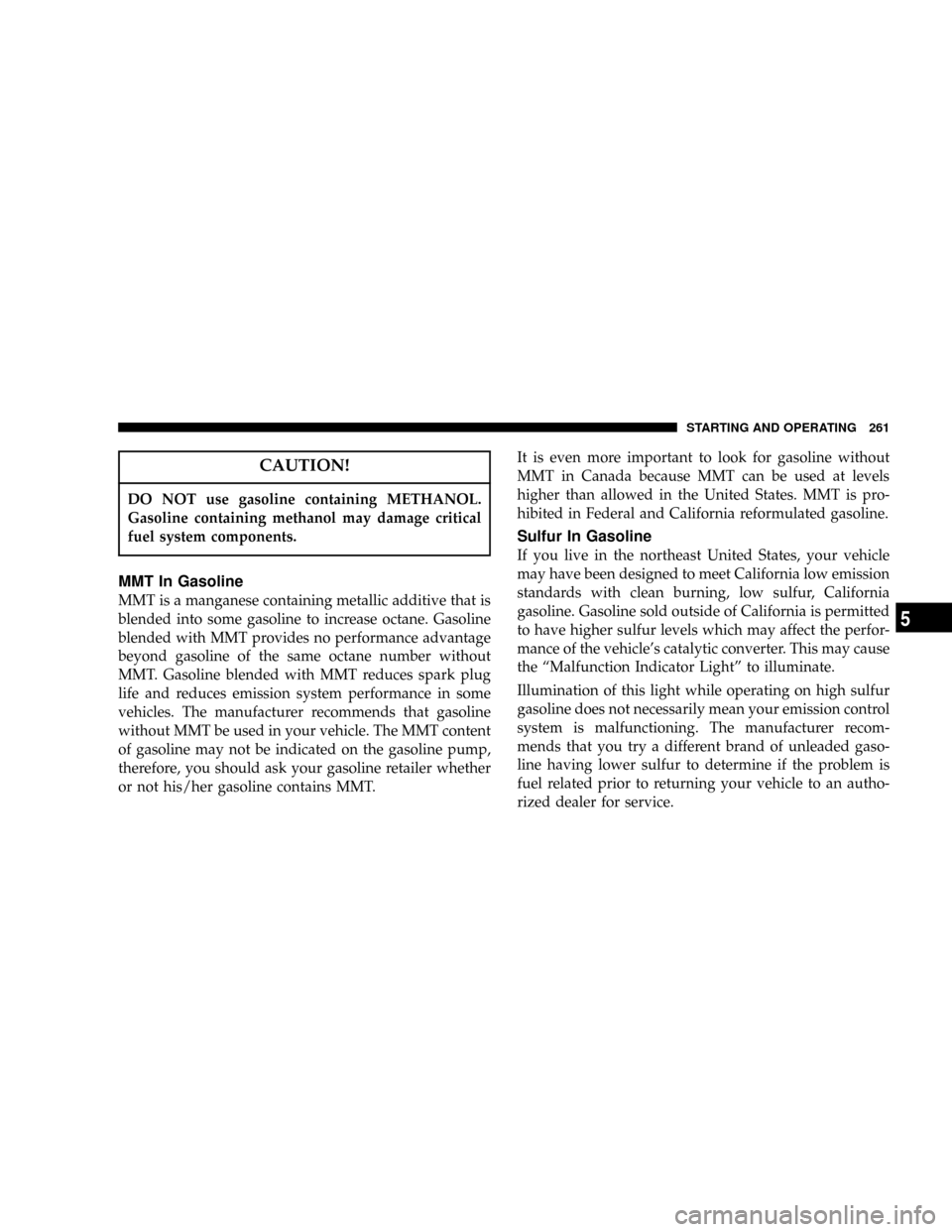Page 242 of 374
EXAMPLE:
Service Description:
95= Load Index
ÐA numerical code associated with the maximum load a tire can carry.
H= Speed Symbol
ÐA symbol indicating the range of speeds at which a tire can carry a load corresponding
to its load index under certain operating conditions.
ÐThe maximum speed corresponding to the Speed Symbol should only be achieved un-
der specified operating conditions. (ie. tire pressure, vehicle loading, road conditions and
posted speed limits).
Load Identification:
(....blank....(= Absence of any text on sidewall of the tire indicates a Standard Load (SL) Tire
Extra Load (XL)= Extra Load (or Reinforced) Tire
Light Load= Light Load Tire
C,D,E= Load range associated with the maximum load a tire can carry at a specified pressure
Maximum LoadÐ Maximum Load indicates the maximum load this tire is designed to carry.
Maximum PressureÐ Maximum Pressure indicates the maximum permissible cold tire inflation pressure for this
tire.
242 STARTING AND OPERATING
Page 256 of 374

Tire Pressure Monitor System Tire/Wheel
Rotation and Sensor Replacement Ð If Equipped
With the TPM System, if a road tire and wheel is replaced
by the spare, the TPM system will detect the swap
automatically (after the ignition has been cycled) and
display SPARE SWAP DETECTED along with a chime.
This could take up to 10 minutes with vehicle speed
above 25 mph (40 km/h).
The tire pressure sensorsmustbe retrained following a
wheel rotation or sensor replacement. Refer to ªEVIC Ð
Retrain Tire Sensorsº in Section 3 for more information. It
is necessary to program the EVIC with the new sensor(s)
or the new position of each sensor as it is rotated to a
different corner of the vehicle.
If a wheel rotation is not followed by the retrain proce-
dure, the system will not properly inform you of the
correct vehicle location of a low or high tire pressure.
Tire Pressure Monitor System/4±LO Mode Ð If
Equipped
When the 4±LO mode is selected, the chime will not
sound until either: the vehicle speed is greater or equal to
25 mph (40 km/h) or the vehicle is taken out of the 4±LO
mode.
The low tire pressure warning messages (on the EVIC)
and the ªTire Pressure Monitor Warning Lightº will
continue to be displayed until the tire pressure has been
increased to the proper operating pressure.
General Information
This device complies with part 15 of the FCC rules and
RSS 210 of Industry Canada. Operation is subject to the
following conditions:
²This device may not cause harmful interference.
256 STARTING AND OPERATING
Page 260 of 374

Light spark knock at low engine speeds is not harmful to
your engine. However, continued heavy spark knock at
high speeds can cause damage and immediate service is
required. Engine damage resulting from operation with a
heavy spark knock may not be covered by the new
vehicle warranty.
Poor quality gasoline can cause problems such as hard
starting, stalling and hesitations. If you experience these
symptoms, try another brand of gasoline before consid-
ering service for the vehicle.
Over 40 auto manufacturer's world wide have issued and
endorsed consistent gasoline specifications (the World-
wide Fuel Charter, WWFC) to define fuel properties
necessary to deliver enhanced emissions, performance,
and durability for your vehicle. The manufacturer recom-
mends the use of gasoline that meets the WWFC speci-
fications if they are available.Reformulated Gasoline
Many areas of the country require the use of cleaner
burning gasoline referred to as Reformulated Gasoline.
Reformulated gasoline contains oxygenates, and is spe-
cifically blended to reduce vehicle emissions and im-
prove air quality.
The manufacturer strongly supports the use of reformu-
lated gasoline. Properly blended reformulated gasoline
will provide excellent performance and durability for the
engine and fuel system components.
Gasoline/Oxygenate Blends
Some fuel suppliers blend unleaded gasoline with oxy-
genates such as 10% ethanol, MTBE, and ETBE. Oxygen-
ates are required in some areas of the country during the
winter months to reduce carbon monoxide emissions.
Fuels blended with these oxygenates may be used in
your vehicle.
260 STARTING AND OPERATING
Page 261 of 374

CAUTION!
DO NOT use gasoline containing METHANOL.
Gasoline containing methanol may damage critical
fuel system components.
MMT In Gasoline
MMT is a manganese containing metallic additive that is
blended into some gasoline to increase octane. Gasoline
blended with MMT provides no performance advantage
beyond gasoline of the same octane number without
MMT. Gasoline blended with MMT reduces spark plug
life and reduces emission system performance in some
vehicles. The manufacturer recommends that gasoline
without MMT be used in your vehicle. The MMT content
of gasoline may not be indicated on the gasoline pump,
therefore, you should ask your gasoline retailer whether
or not his/her gasoline contains MMT.It is even more important to look for gasoline without
MMT in Canada because MMT can be used at levels
higher than allowed in the United States. MMT is pro-
hibited in Federal and California reformulated gasoline.
Sulfur In Gasoline
If you live in the northeast United States, your vehicle
may have been designed to meet California low emission
standards with clean burning, low sulfur, California
gasoline. Gasoline sold outside of California is permitted
to have higher sulfur levels which may affect the perfor-
mance of the vehicle's catalytic converter. This may cause
the ªMalfunction Indicator Lightº to illuminate.
Illumination of this light while operating on high sulfur
gasoline does not necessarily mean your emission control
system is malfunctioning. The manufacturer recom-
mends that you try a different brand of unleaded gaso-
line having lower sulfur to determine if the problem is
fuel related prior to returning your vehicle to an autho-
rized dealer for service.
STARTING AND OPERATING 261
5
Page 262 of 374
CAUTION!
If the ªMalfunction Indicator Lightº is flashing,
immediate service is required. See ªOnboard Diag-
nostic Systemº in Section 7 of this manual.
Materials Added To Fuel
All gasoline sold in the United States is required to
contain effective detergent additives. Use of additional
detergents or other additives is not needed under normal
conditions.
FUEL TANK FILLER CAP (GAS CAP)
WARNING!
To avoid fuel spillage and overfilling, do not ªtop
offº the fuel tank after filling.
The gas cap is located behind the fuel filler door, on the
left side of the vehicle. If the gas cap is lost or damaged,
be sure the replacement cap has been designed for use
with this vehicle.
When tightening the gas cap, tighten until 2 or 3 clicks
are heard to insure that the cap is properly seated.
NOTE:A loose gas cap may cause the ªMalfunction
Indicator Lightº to illuminate.
262 STARTING AND OPERATING
Page 265 of 374
CAUTION!
If the trailer weighs more than 1,000 lbs (454 kg)
loaded, it should have its own brakes and they
should be of adequate capacity. Failure to do this
could lead to accelerated brake lining wear, higher
brake pedal effort, and longer stopping distances.
WARNING!
Connecting trailer brakes to your vehicle's hydraulic
brake lines can overload your brake system and
cause it to fail. You might not have brakes when you
need them and could have an accident.
²Whenever you pull a trailer, regardless of the trailer
size, stop lights and turn signals on the trailer are
mandatory for motoring safety.
²Follow the maintenance intervals in schedule ªBº for
changing the automatic transmission fluid and filter, if
you REGULARLY tow a trailer for more than 45
minutes of continuous operation.
STARTING AND OPERATING 265
5
Page 277 of 374
5. Raise the vehicle by turning the jack handle clockwise
until the tire clears the ground.
WARNING!
Raising the vehicle higher than necessary can make
the vehicle less stable and cause an accident. It could
slip off the jack and hurt someone near it. Raise the
vehicle only enough to remove the tire.
6. Remove the lug nuts and wheel.
7. Position the spare wheel/tire on the vehicle and install
lug nuts with cone-shaped end toward wheel. Lightly
tighten nuts clockwise. To avoid the risk of forcing the
vehicle off the jack, do not tighten the nuts fully until the
vehicle has been lowered.
8. Lower the vehicle by using a counterclockwise rota-
tion to lower the jack.
Rear Scissor Jack Location
WHAT TO DO IN EMERGENCIES 277
6
Page 279 of 374

²Do not let passengers sit in the vehicle when it is on a
jack.
²Do not get under the vehicle when it is on a jack.
²Failure to follow the ªTire Changing Procedureº may
result in personal injury or damage to your vehicle.
²Only use the jack in the positions indicated.
JUMP STARTING PROCEDURE
NOTE:Check the charge indicator on the battery. If the
indicator is light or yellow, replace the battery.
1. Wear eye protection and remove any metal jewelry
such as watch bands or bracelets that might make an
unintended electrical contact.
2. When boost is provided by a battery in another
vehicle, park that vehicle within booster cable reach but
without letting the vehicles touch. Set the parking brake,place the automatic transmission in P (Park), or manual
transmission in N (Neutral), and turn the ignition to OFF
for both vehicles.
3. Turn off the heater, radio and all unnecessary electrical
loads.
4. Connect one end of a jumper cable to the positive
terminal of the discharged battery. Connect the other end
of the same cable to the positive terminal of the booster
battery.
5. Connect the other cable, first to the negative terminal
of the booster battery and then connect the other end to
a non-paint metal surface on the engine of the vehicle
with the discharged battery. Make sure you have a good
contact on the engine.
6. Start the engine in the vehicle which has the booster
battery, let the engine idle a few minutes, then start the
engine in the vehicle with the discharged battery.
WHAT TO DO IN EMERGENCIES 279
6